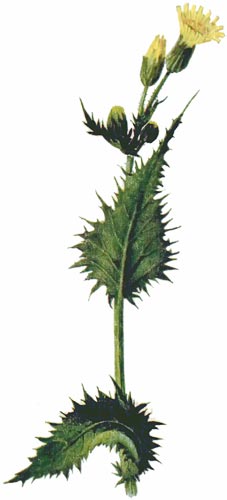Weeds
Sonchus asper (L.) Hill. - Prickly (Rough, Spiny) Sowthistle
Systematic position.
Family Asteraceae, genus Sonchus L.Biological group.
Annual weed forming rootstocks.Morphology and biology.
Root stalky, vertical. Stem straight, branchy, glabrous below, 70-80 cm in height. Leaves integral or emarginate-incised, with sharp incisions and prickly marginal denticles, elongate-ovoid, rigid, pointed, less often blunt; radical and lower stem leaves are narrowed toward winged petiole; middle and upper leaves sessile, with wide amplexicaul basis. The lower leaves (together with petiole) 9-17 cm in length, larger than middle (6-7 cm in length) and upper ones (1.5-3 cm in length). Inflorescences are calathidia, aggregated at the end of stalk and branches in small umbrella-shaped corymbs. Flower stalks and involucre are covered with dark glandular hairs, sometimes the hairs are absent at the upper parts of flower stalk. All flowers in calathidia are bisexual, ligular, yellow. Hemicarps are bright-brown, elongate-obovoid, 2.5-3 mm in length, 0.75-1 mm in width, flattened, with three longitudinal ribs on each side, with a ring-shaped bolster on one side and a pappus on another one; its hairs are simple, white, the pappus easily falls down. Blossoms June unil October. In autumn, stem and main leaf veins get reddish-lilac tint with the approach of cool weather.Distribution.
Almost all Western Europe, Asia Minor, Iran, Afghanistan, the Himalaya, Mongolia, South and East Asia, North and South America, Australia. On territory of the former USSR, the species is distributed in almost everywhere over the European part, in the Caucasus, Western and Eastern Siberia, in the Far East and Central Asia.Ecology.
The species grows on garbage places at habitations, in kitchen gardens, less often in crops of field cultures, mainly on fertile damp soils.Economic significance.
The weed litters vegetable and fruit-berry cultures. Control measures include crop rotation, deep treatment of ground, weeding, mowing of the weed on untreated grounds, application of herbicides if necessary.Reference citations:
Melnichuk, O.S. & Kovalivska, G.M. 1972. Atlas of the most widespread weeds of the Ukraine. Kiev: Urozhai, 204 p. (in Ukrainian).Shishkin, B.K., ed. 1965. Flora of the Leningrad Region. V. 4. Leningrad: LGU. 360 p. (in Russian).
Simonov, I. 1969. Weeds and their control. Sverdlovsk: Sredne-Ural`skoe Publishing House. 132 p. (in Russian).


